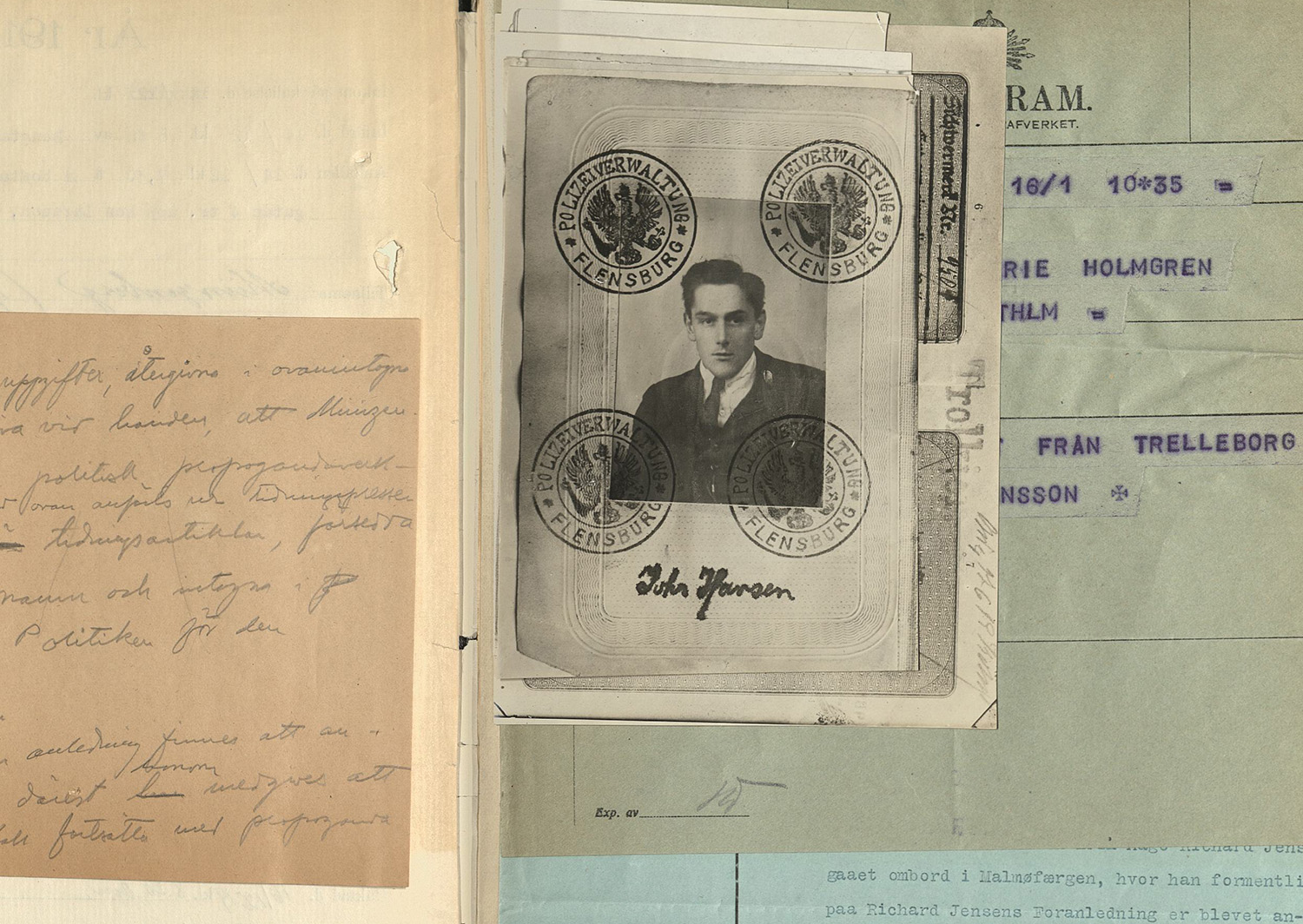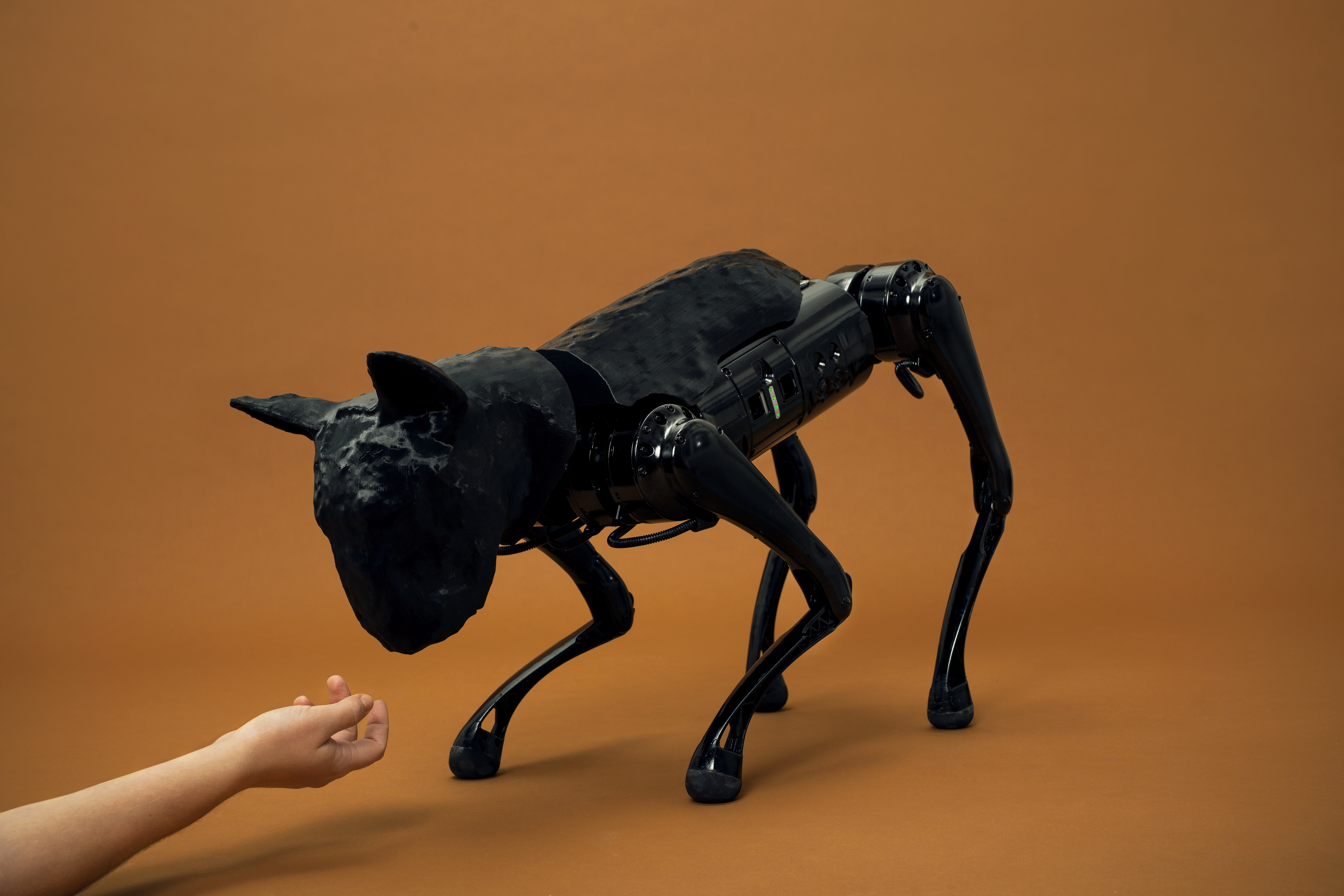THIS LAND 4 ALL
Accelerator presented a solo exhibition of Hanni Kamaly, entitled THIS LAND 4 ALL, which ran concurrently with Mona Hatoum’s exhibition So Much I Want to Say. THIS LAND 4 ALL comprised new works in dialogue with historical publications and artworks. The new works had been produced following Kamaly’s research in the collections of Stockholm University. The exhibition was open 19 March–19 June, 2022.
 Background: Archive image of students demonstrating in Stockholm, February 1939. Photographer: unknown.
Background: Archive image of students demonstrating in Stockholm, February 1939. Photographer: unknown.
About the exhibition
Hanni Kamaly works primarily with video, sculpture and performance. Through in-depth research into archives and collections, the artist follows traces of bodies that have been denied their names and agency throughout history. Fragments from various forms of dehumanisation within visual culture, ethnography and institutions of power are interwoven in the works, exposing patriarchal, colonial, racist and nationalist structures that extend into the present.
In THIS LAND 4 ALL, Kamaly has focused on the Swedish history of nationalism and the connections between scientific racism, art history and academia. Kamaly’s work reveals the influence of art on the construction of a Swedish national identity through history, in addition to Romantic nationalism’s connections to fascism. Kamaly’s longtime use of mind-mapping as an artistic method is visible in THIS LAND 4 ALL, where subjects are connected to each other through the historical artefacts and the newly created artworks in the exhibition. Kamaly’s reconstructed network elucidates structural oppression in the Swedish cultural-historical canon.
Accelerator was hosting walks and seminars in relation to the exhibition.
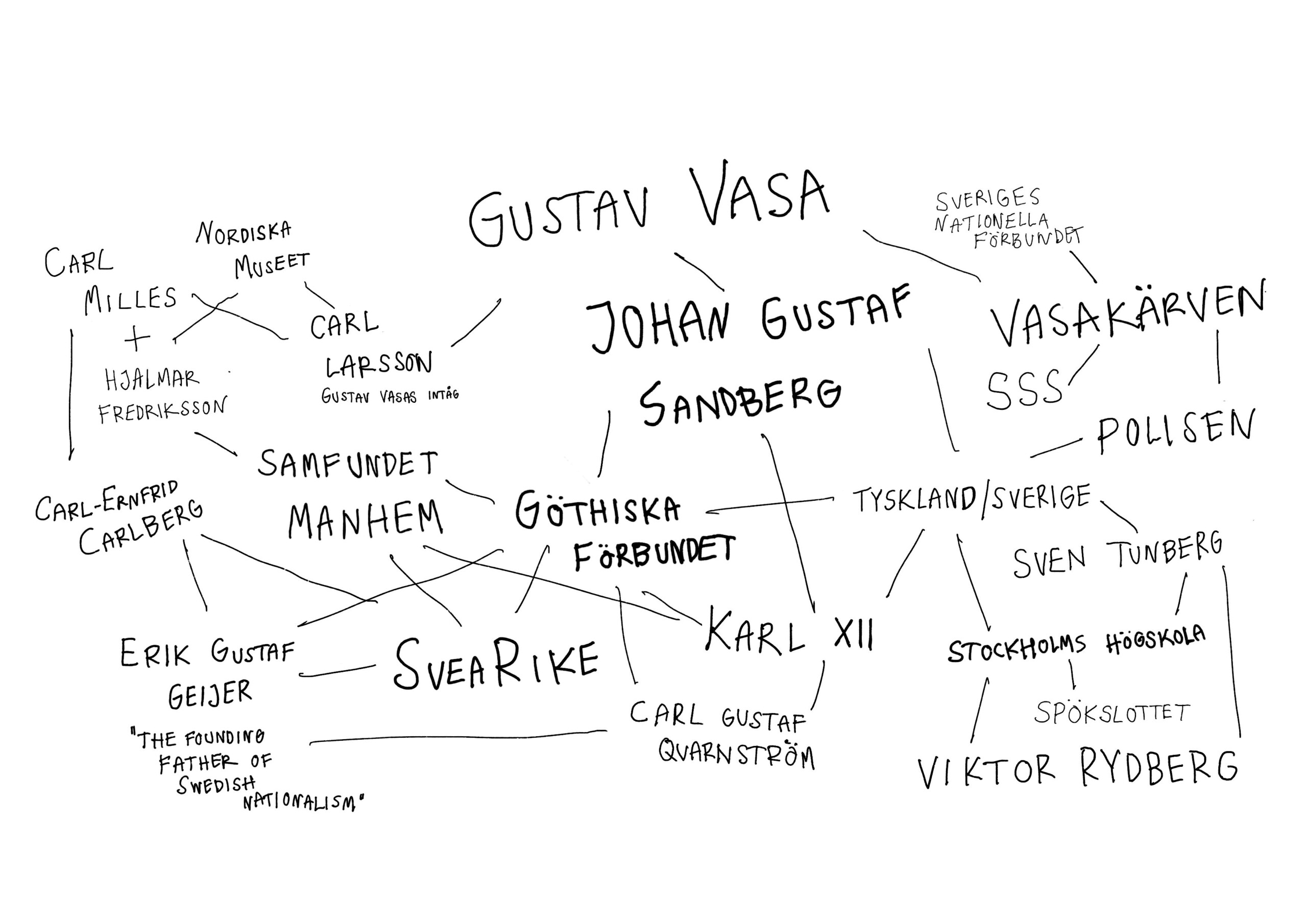
Works in the exhibition
Svenska folktyper: bildgalleri, ordnat efter rasbiologiska principer och med en orienterande översikt (Swedish Racial Types: Picture Gallery, organised according to racial biological principles) by Dr. H. Lundborg, 1919. Book, 236 p. 1919. AB Hasse W Tullbergs förlag, Stockholm. In the artist’s possession.
Herman Lundborg (1868–1943), was a medical doctor and the founder of the State Institute for Racial Biology in Sweden. Lundborg developed methods for race studies, that were later employed by Nazi Germany. The book presented in the exhibition THIS LAND 4 ALL was published in conjunction with the 1919 Exhibition of Swedish Racial Types, which was co-organised by Lundborg. The book, owned by the artist, forms the point of departure for the work on the sculptures in the exhibition.
The 1919 Exhibition of Swedish Ethnic Types was shown in Stockholm, Uppsala, Gävle, Visby and Göteborg, and aimed to stimulate interest in racial biology. Shortly after the exhibition, the Swedish parliament unanimously voted for the establishment of the State Institute for Racial Biology, which was inaugurated in Uppsala 1922. The exhibition claimed to present findings on the racial make-up of the Swedish people and displayed photographs, paintings and sculptures that purported to demonstrate typical racial features. The Nordic race was represented by famous personalities such as Jenny Lind, whose portraits were in stark contrast to the section “Foreigners”, which featured police photographs of unnamed persons. Lundborg’s many high-profile friends in the cultural and scientific communities, including Sven Hedin, Anders Zorn, Ellen Key and Verner von Heidenstam, supported the exhibition financially.
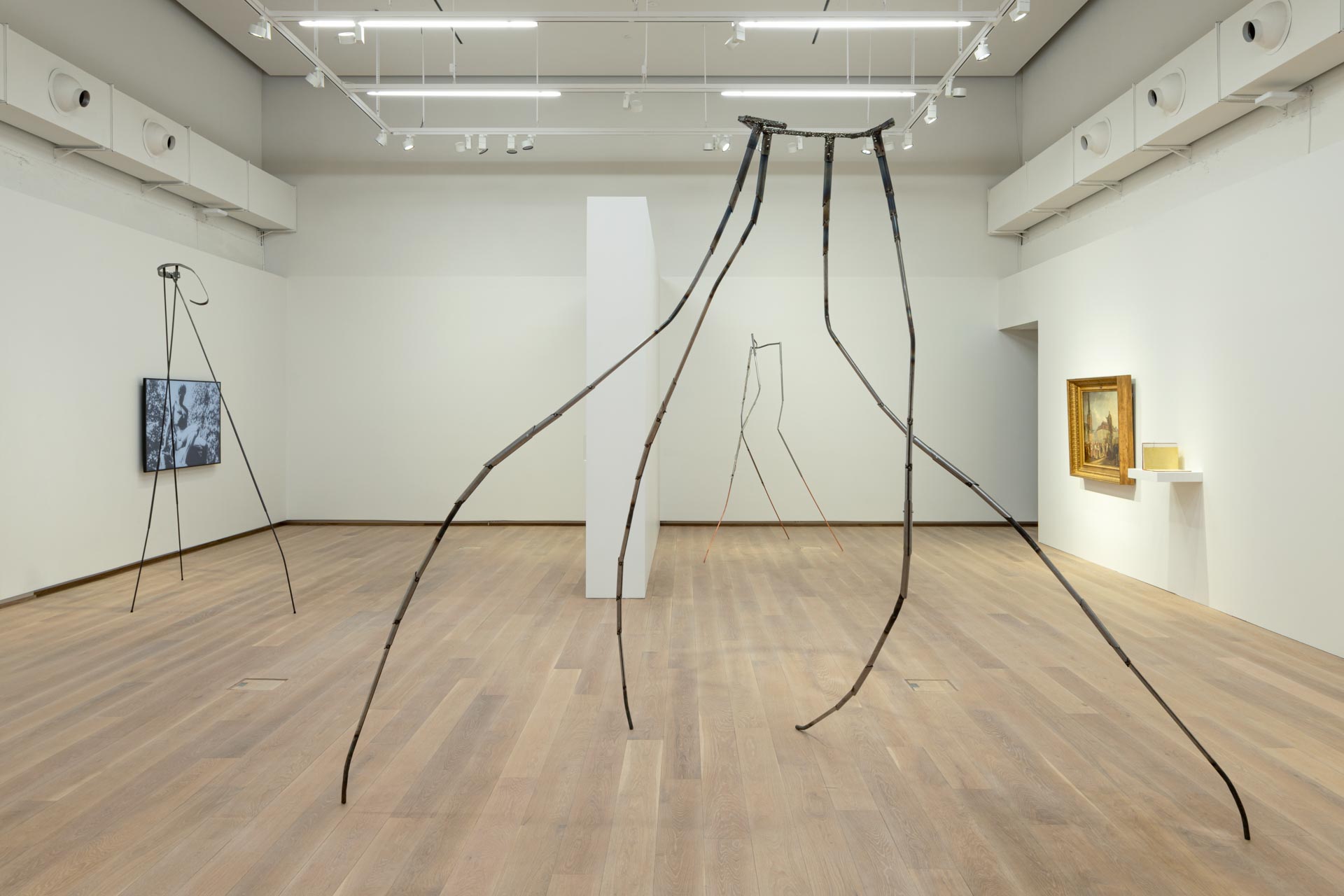
BICHIDA ABDALLAH, 2022. Steel, copper, brass. 251 x 224 x 100 cm.
GEORGE CAMERBACH, 2022. Steel. 285 x 360 x 112 cm.
LIAN TSCHENG, 2022. Steel. 220 x 193 x 128 cm.
JUAN SALAZAR, 2022. Steel. 279 x 230 x 87 cm.
MUSSARD YAHIA, 2022. Steel. 160 x 81 x 57 cm.
The titles of the five new sculptures Kamaly has created for THIS LAND 4 ALL are all based on subjects featured in Herman Lundborg’s book Swedish Racial Types and in the Exhibition of Swedish Racial Types.
Their portraits appear anonymously in the chapter titled Utlänningar (Immigrants). Instead of being named, they are referred to as “a mixed-race individual, criminal”, “a Japanese circus artist with European blood”, “a vagrant”, and similar descriptions.
After having discovered the book and the portraits, Kamaly searched for these persons’ names in various archives without any results. Several years later, conducting research for another project, the artist came across a number of named portraits in a journal published in 1879–1983 by the Swedish Police Authority in Stockholm.
Hanni Kamaly has previously created sculptures that are given titles based on people who have been subjected to state violence. Marking the bodies, acts of dehumanisation erases any trace of subjectivity and agency from history. Kamaly’s sculptures materialise these traces by using materials that are linked to the history of colonial violence.
With the artist’s long-standing interest in museology and various forms of memory work, Kamaly’s sculptures become a form of anti-monuments in an unheroic writing of history. Kamaly explores issues of commemoration; how we remember, who we will remember, and the nature of monuments.
Den nordiska mytos, 2022, HD-video, 10:50 mins.
Near the Lillsved Sports and Gymnastics Folk High School (idrottsfolkhögskola) at Värmdö outside Stockholm, there is a three metre tall sun cross. The monument “Den nordiska mytos” (The Nordic Myth, or Mythology) by artist Johan Hjalmar Zackrisson was erected in 1939 by Samfundet Manhem, a pro-Nazi association active 1934–1944. The association was modelled on the Geatish Society (Götiska förbundet, further information below), and primarily focused on “folkstamvård” (eugenics). Its members included doctors, lawyers, engineers, officers and art professionals.
The Manhem Association and the Lillsved Sports and Gymnastics Folk High School were founded by Carl-Ernfrid Carlberg, an affluent officer, engineer, gymnast and for decades the foremost mecenat of the Swedish far-right movement. At the 1912 Olympic Games in Stockholm, Carlberg won a gold medal in gymnastics. Sport, body culture and art were closely related in Carlberg’s activities and a central theme in Swedish national socialism.
LOOT THE NATION, 2022, HD-video, 4:10 mins.
When the post-colonial philosopher and polemicist Frantz Fanon (1925–1961) at early age encountered the monument of the French abolitionist Victor Schœlcher on Martinique, it marked the start of his critical thinking. The monument, according to Fanon, made freedom impossible for colonialised people and demonstrated the prevailing white power structure. The monument was demolished during the 2020 Black Lives Matter movement.
LOOT THE NATION intertwines images of the Schœlcher monument and a quotation by Sven Hedin. Hedin argued against the erection of a peace monument to celebrate the dissolution of the union between Norway and Sweden. Employing a diverse range of historical fragments, Kamaly addresses the impossibility of a monument to completely disengage itself from the originator’s intended history writing.
Hitler’s speeches from the library of Sven Hedin. Magazine file, 17 booklets. 1939–1943. Svea Rikes Förlag, Valkyrian, Müller & Sohn, Klara civiltryckeri AB. On loan from Sven Hedin’s library, deposited in Stockholm University Library.
The Stockholm University Library’s special collections comprise Sven Hedin’s deposited library. Hedin (1865–1952) was an internationally known explorer and a member of the Swedish Academy and the Royal Swedish Academy of Sciences. He was a friend of King Gustav V and of many influential politicians and intellectual leaders of the early 20th century. Hanni Kamaly has studied Hedin’s library and chosen to borrow a magazine file containing 17 of Adolf Hitler’s speeches from 1939 to 1943.
Sven Hedin admired Hitler and visited him several times during the Second World War. Following Hitler’s suicide in 1945, Hedin described him as “one of the greatest men in the history of the world” in an obituary published in the daily Dagens Nyheter. Hedin was criticised for his affiliation with the German Nazis but few people distanced themselves from him. In 1954, two years after his death, the art gallery Liljevalchs in Stockholm organised an exhibition honouring Sven Hedin, supported by the King and a large number of prominent scientists.
Hitler’s 1939 speech “I believe in a long peace” may be regarded as an example of how propagandistic distortion of the truth turns into something extremely dangerous, of which we see parallels to the rhetoric and desinformation used by Putin today. The speech was published by Svea Rikes förlag run by the Swedish Nazi Carl-Ernfrid Carlberg. Carlberg was a key person in the Swedish nationalist networks, which Kamaly has investigated, and features in the video work THIS LAND 4 ALL.
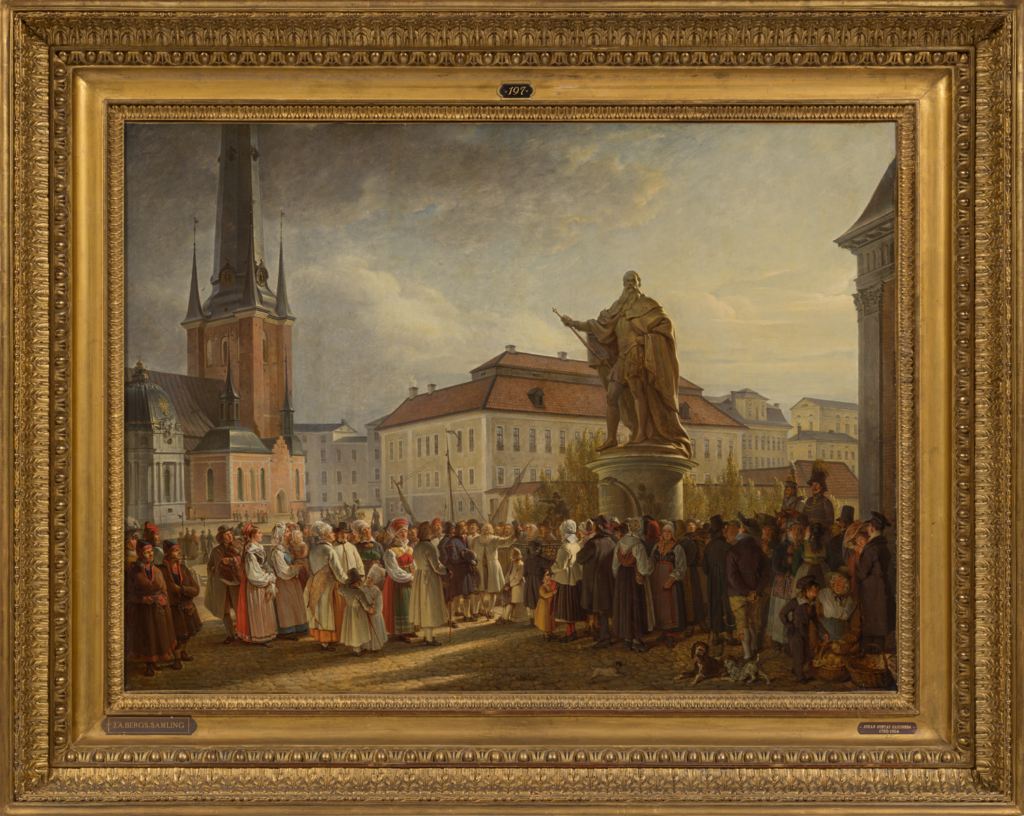
Johan Gustaf Sandberg. Svensk allmoge, samlad kring Gustaf Vasas staty på Riddarhustorget (Swedish peasantry, gathered around the statue of Gustaf Vasa at the Square of the House of Nobility), 1828. Oil on canvas. On loan from the art collection of Stockholm University, SUBS197, J A Berg’s Foundation.
Artist Johan Gustaf Sandberg (1782–1854) was primarily a history painter depicting motifs from Norse mythology and Swedish history, in particular that of Gustav Vasa as the founder of the nation. The painting features people from throughout Sweden, dressed in folk costumes, gathered at the Square of the House of Nobility, in Stockholm. Huddled close together, they look at the statue of Gustav Vasa. A group of Sámi people are separate from the rest of the crowd.
Sandberg was a member of the Geatish Society, an influential cultural association that glorified the past and promoted “patriotic endeavours and research into Norse mythology”. The members created artworks and a large number of poems that portrayed Swedes as a unified, noble and ancient people. Comprising fictitious characters and events from Swedish history, the poems were taught in schools for 150 years and contributed to shaping the idea of what is Swedish.

THIS LAND 4 ALL, 2022. HD-video, 12:03 mins.
Kamaly’s explorations are centred on the human body as a projection surface for ideologies and power structures. The video work THIS LAND 4 ALL traces the Swedish history of nationalism by focusing on the gaze on the body. Initially, the erection of monuments are depicted as a kind of embodied nation building. Kamaly’s time axis harks back to the time after Sweden had lost Finland in 1809 when the Geatish Society was founded in 1811. Romantic nationalism was flourishing and ideas of the “Swedish soul” and the motherland were central cultural concepts.
The video work THIS LAND 4 ALL forms a web of body culture, art, poetry and Swedish national socialism through events such as the 1912 Olympic Games in Stockholm, the 1919 Exhibition of Swedish Ethnic Types and the 1939 student demonstrations against the immigration of Jewish medical doctors. The result is a portrait of how a nation’s memories and conceptions of its history have been constructed through cultural expressions by influential nationalist associations. Carl-Ernfrid Carlberg and Herman Lundborg, who also appear in other works in the exhibition, are here central figures.
About Hanni Kamaly
Hanni Kamaly (b. 1988, Norway) is a visual artist based in Stockholm. Kamaly received an MFA from Malmö Academy of Art and has also studied at Bergen Academy of Arts and the International Art Academy of Palestine.
Kamaly’s work has been exhibited in numerous institutions and spaces including KINDL, Berlin (2022), Göteborgs konsthall (2021–2022), Mint, Stockholm (2021), Index, Stockholm (2021), Oslo kunstforening (2021–2021), Moderna museet in Stockholm (2018–2019) and Malmö (2020), coyote, Stockholm (2020), Interkulturelt Museum, Oslo (2019–2020), Lunds Konsthall (2019), Ginerva Gambino, Cologne (2019), Tegel, Stockholm (2019), Malmö Art Museum (2017–2018), Skånes konstförening, Malmö (2017), Almanac, London (2017), Rupert, Vilnius (2016). Kamaly has also participated in the Luleå Biennial (2018–2019) and the 34th Bienal de São Paulo in 2021, and is one of the artists invited to the Sharjah Biennial, UAE in 2023.
Credits
Hanni Kamaly, Artist
Exhibition team Accelerator:
Therese Kellner, Curator
Richard Julin, Artistic Director
Erik Wijkström, Exhibition Technician
Ruby Brown, Intern
Accelerator wishes to thank:
Camilla Hjelm, Curator, Stockholm University Art Collections
Tommy Westergren, Librarian, Stockholm University Library
The artist wishes to thank:
Simon Ferner
What's on at Accelerator
Calendar

